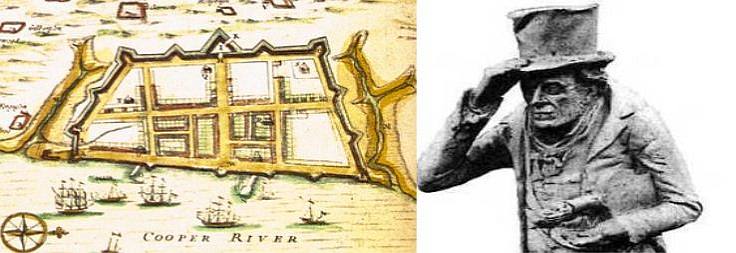James Stuart (1728 – 1844) or “Jimmy Strength” as he was fondly known in Berwick and the surrounding area was born, by his own account, in Charlestown (now Charleston), South Carolina, on Christmas Day 1728. He died in Tweedmouth, on the 11th April 1844, aged 115. Mythology surrounds the life of James Stuart, but his story still endears him to many in the Berwick area.
Collected below are some of the published reports about him – and about the statue which commemorated him.
|
The Berwick Advertiser, 13 April 1844 (p.4, col.4), published the following account of the life of James Stuart, two days after his death:
Death of a Gentleman It is this week our duty to record the death of James Stuart, who has latterly attracted considerable attention by means of notices which have appeared in other periodicals besides the newspapers throughout the country.
Although the task of his biographer has thus been to a great extent anticipated, we yet feel disposed to notice at some length the peculiar circumstances and incidents of his life and history, even at the hazard of repeating what is familiar to the public already.
James Stuart, who died at Tweedmouth yesterday (Thursday) morning, was born, according to his own statement, at Charlestown, South Carolina, on Christmas day 1728, and he was consequently 115 years old at Christmas last. He was the only son of General John Stuart, and grandson of Lady Airlie, famed in Scottish song, as having been taken out of her house at Airlie by a party of clan Campbell, and killed. Mr Chambers of Edinburgh recently showed that Lady Airlie’s daughter must have been 80 years of age in 1728, and, of course, in this part of Stuart’s statement there must be a serious mistake. Shortly after the birth of Stuart, his father died, when he and his mother came to Scotland and took up abode at Aberdeen, where he was brought up and educated. At the time of the rebellion in 1745 he was at Prestonpans; he had a perfect recollection of the battle which took place there between the forces of the Pretender and those of the government, and had seen Colonel Gardiner who fell there, and whom he described as a gentlemanly looking man, and much loved by his soldiers. Sometime after this, Stuart enlisted into the 42d Highlanders. Under General Wolfe he was engaged at the battle of Bunker’s Hill, in 1755, and was at Quebec when that distinguished officer fell. He remained in this regiment eight years, and was advanced to an ensigncy, when he sold out. He subsequently entered the navy, and served on board the Prince of Wales, 74, for 22 years. While in the navy, he was under Admiral Rodney, at the taking of Comte de Grasse in the West Indies. He was noticed by General Abercromby, and entertained at his table at Aboukir house. Sometime after, he was discharged and again returned to Scotland. Being without occupation or business, he joined the Aberdeenshire militia which was raised, along with many others at the renewal of the French war, to protect our shores from invasion, and with that regiment came to Berwick.
From the above brief sketch of the more material incidents of his life, it appears that he was no slight participator in the stirring events of his time. While in the service of his country he was thrice married and twice since. The families by the first three wives entered the service of their country; two of his sons fell at Trafalgar; three were at Algiers, and some of them were at almost every engagement during the Peninsular campaign. His family in all amounted to 27. Those by the last two wives followed the vagrant life led by their father when they were born.
Besides his longevity he was, till about thirty years ago, remarkable for muscular power, and became familiarly known by the designation of “Jamie Strength.” While perambulating the town and country as a musician, he was frequently prevailed upon to display his Herculean vigour. We have heard him state that the greatest weight he lifted from the ground was 105 stones, and that he had lifted with one hand 83 stones. When the Forfarshire militia were encamped at Eyemouth, he went to see an acquaintance amongst them; while there a dancing master was boasting much of his strength, when one of the soldiers, knowing Stuart, engaged with the boaster to produce a drummer who would lift more than he could. Stuart was dressed as a drummer brought into the presence of the man of pumps. A piece of ordinance was lying before them, which the dancing master raised to a perpendicular and then allowed it to fall. He asked the drummer whether he could do that. Stuart pretended he was not very sure that he could; but, placing his arms round the piece, he raised it entirely from the ground, carried it to some distance, and then desired the dancing master to remove it to its former place. This however he declined attempting and forever ceased his boasting. At a another time, when at Velvet Hall, a little to the west of this, some country men were labouring to get a cart laden with hay out of a miry-hole into which by some accident it has stuck fast, Stuart was appealed for assistance. He desired them all to stand aside, and, going underneath he cart, he removed it with its load to the opposite side of the road. Various other feats of a similar nature he performed in the public houses in the towns which he visited as a musician, and where he was always made welcome by the different companies assembled, as he was of mild temper, had an excellent memory, and was very entertaining in reciting what he had seen and learned in his routes.
He claimed relationship to the Stuart family, the last of Scotland’s kings, and, in 1822, when George the Fourth was about to visit Edinburgh, Jamie was invited by Sir George Sinclair to repair thither and be introduced to his Majesty. Stuart was accordingly dressed in new regimentals and forwarded by coach. His Majesty’s voyage, it will be recollected, was prolonged by contrary winds, and, amongst others, whose patience was worn out, was Stuart, who came home before the king landed. Having disburthened himself of his regimentals and walked the entire distance. To those who enquired the cause of his speedy return, he replied that “he could nae be fashed waitin’ o’ the king”.
We have before stated that his first coming to Berwick was with the Aberdeenshire militia, somewhere about fifty years ago. On the breaking up of that body, he took up his residence in the district, residing principally at Tweedmouth. The greater portion of the year he travelled the country as a musician; but, although he had long practice on the violin, he never reached even mediocrity as a performer; and said of himself that he was only a “scraper.” As the inhabitants of the districts he visited had every confidence in his honesty, sobriety and truthfulness, he was everywhere received with welcome. He was far from obtrusive notwithstanding his mode of life; as he was never known to solicit alms, and we never heard anyone say that he had been tipsy.
His memory latterly has failed him, a circumstance of which he was aware, and often expressed regret that the questions which have, at a comparatively recent period, been put to him had not been put 20 years earlier. Possibly this circumstance may account for his obvious error regarding the exact relationship of his mother to “Lady Airlie”.
The immediate cause of his death was a fall which he had had on Thursday last week at the door of his house, by which his hip joint was fractured, and he sustained other injuries under which his great infirmity was unable to bear up. He gradually sunk under them till yesterday morning, when, as above related, he expired, breaking a link that connected the present with an age long gone by.
A twelvemonth ago, at the New Year, a fund amounting to £40 was raised for his support, to which Her Majesty and Sir Robert Peel contributed. It has sufficed to maintain him in moderate comfort, and we believe, a small surplus will still remain after defraying the funeral expenses. It is due to his wife to state that she has earned the highest approbation of all who sympathised with him under his extreme age and infirmity, by the uniform and affectionate care with which she ministered to his wants and comforts. |
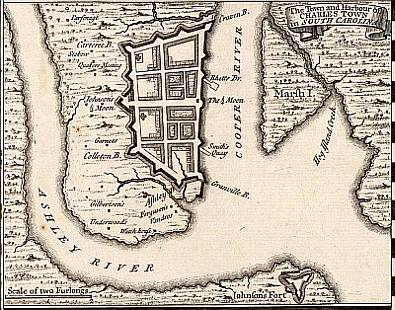 This 1733 map of Charleston, South Carolina was produced five years after the birth of James Stuart, in what he said was his birthplace. A certain similarity can be seen in the fortifications of Charleston and Berwick-upon-Tweed. Image: Herman Moll (public domain) via Wikimedia Commons.
In the Berwick Advertiser, 13 September 1878 (p.3, col.3), it is said that after running away from school, James Stuart “followed the Pretender, being present at the battle of Prestonpan and Culloden as a spectator“. It adds that he also fought with General Wolfe in Quebec, and he was also present at Bunker’s Hill in 1775. The article however ends on a sobering note saying, “His stories, however, were entirely disbelieved by most people on the Borders“.
The Berwick Advertiser, 9 August 1878 (p.3, col.2), refers to his great strength, saying that he “had such strong jaws that he could lift an ordinary kitchen table with, it is said, two people sitting on it, by his teeth“.
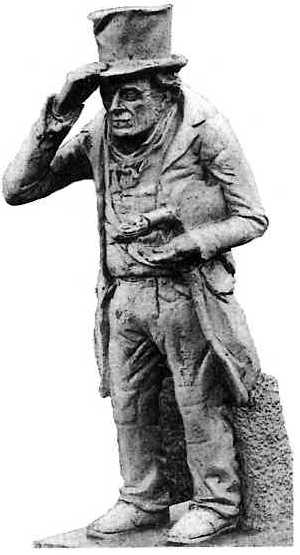 The stone statue of James Stuart was created in 1844 by James Wilson, artist and lighthouse keeper, who lived in Pier House in Berwick and was a pupil of the local artist Thomas Sword Good.
The statue of James Stuart was made before he died: it is mentioned in the Berwick Advertiser, 20 April 1844, in connection with his funeral. “It will be seen by advertisements that the stone figure executed by Mr. Wilson is proposed to be disposed of by lottery.“
Some of the statue’s later history is indicated by reports from 1878. Berwick Advertiser, 9 August 1878 (p.3, col.2) refers to a proposed sale: “It has long been a an object of curiosity to people perambulating the Ramparts“. The article adds that since many people have no knowledge of who the statue represents, it was in danger of being neglected. Berwick Advertiser, 13 September 1878 (p.3, col.3) says that the statue has been sold for at least £10: “this piece of sculpture has for many years stood in the garden adjacent to Bay View House“. (This article also refers to its subject as “Jemmy Strength”, probably reflecting the local pronunciation of the name.)
The statue was subsequently removed to the grounds of the Tweed Brewery in Palace Green. From there it was repositioned outside the Subscription Reading Rooms in Palace Green. In April 1953 workmen accidentally broke the statue and it was removed to be repaired at John Wilson and Sons, Sculptors, Tweedmouth at the end of the Old Bridge. A photograph of the statue in the Berwick Bulletin in 1978 taken at Wilsons, Sculptors showed it to be on its side with the main torso virtually intact. Since 1990 what now remains of the statue is stored at the Berwick Barracks.
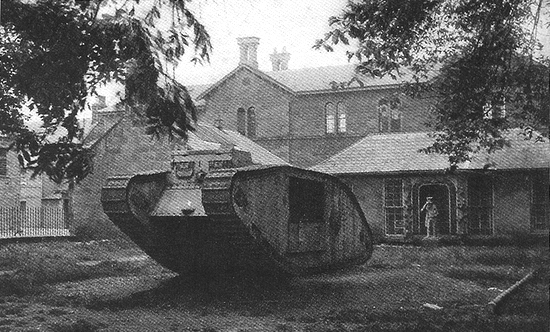 On this photograph the statue of James Stuart can be seen outside the Subscription Reading Rooms in Palace Green facing a WW1 tank on the grassed area at the front. The WW1 tank came to the Palace Green in 1919.
Funeral Service The funeral service for James Stuart took place at Tweedmouth Parish Church on Sunday, 14th April, 1844, attended by a large congregation which packed the church to overflowing. Afterwards his body was interred in the churchyard.
Death Certificate The death certificate of James Stuart was signed by his only surviving son William Stuart marked by an ‘X’. The certificate states James Stuart’s age as 116, it should have been 115. Click here to view his death certificate.
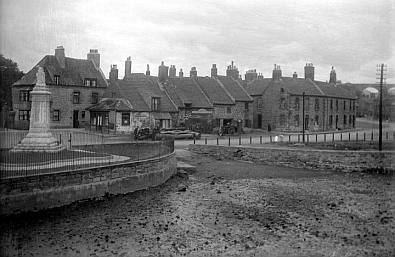 This photograph looking towards West End, Tweedmouth from the Old Bridge shows the area where James Stuart lived. It was taken at the beginning of the 20th century, as a number of the houses in the foreground were demolished to make way for the Royal Tweed Bridge which opened in 1928.
Many of the extracts above are taken from an article in the |
The map of Charleston, South Carolina, in the banner heading dates from 1711. Author unknown (public domain), via Wikimedia Commons.

